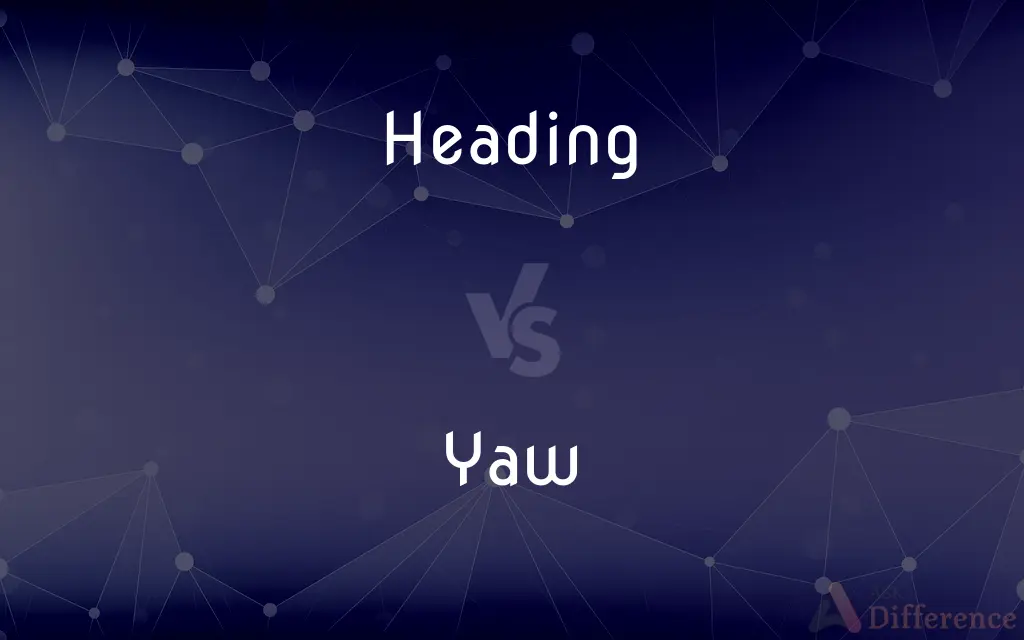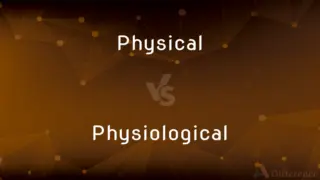Heading vs. Yaw — What's the Difference?
By Maham Liaqat & Urooj Arif — Updated on March 8, 2024
Heading refers to the direction in which a vessel's or aircraft's nose is pointing, measured in degrees from north, while yaw is the rotation of vessel or aircraft around its vertical axis, affecting its horizontal orientation without altering direction.

Difference Between Heading and Yaw
Table of Contents
ADVERTISEMENT
Key Differences
Heading is a navigational term that indicates the direction in which the nose of a ship or aircraft is pointed, relative to a reference point, usually true north or magnetic north. This direction is crucial for navigation, determining the path that the vessel or aircraft will follow across the surface of the Earth. On the other hand, yaw describes the side-to-side movement of the nose of the vessel or aircraft around its vertical axis. Yaw movement results in a change in the horizontal orientation of the vessel or aircraft, but not necessarily in its overall travel direction, which is determined by the heading.
In aviation and maritime operations, maintaining an accurate heading is essential for reaching a desired destination. Pilots and captains must constantly monitor and adjust the heading to account for environmental factors such as wind or currents. Whereas, yaw is often adjusted to maintain stability or make precise directional changes, especially during maneuvers like turning or when compensating for wind effects to maintain a straight flight path or navigation course.
The instruments used to measure and maintain heading and yaw are different, reflecting their distinct roles. A compass or a gyrocompass is typically used to determine heading, providing a constant reference to magnetic or true north. Yaw, however, is monitored using gyroscopic instruments, such as a turn coordinator or yaw damper, which provide real-time feedback on the rotational movement around the vertical axis.
The control mechanisms for adjusting heading and yaw also differ. To change heading in an aircraft, a pilot might use the ailerons to bank the aircraft, which indirectly affects the heading through a coordinated turn involving both yaw and roll. In contrast, to directly control yaw, the pilot uses the rudder, which pivots the aircraft left or right around its vertical axis without banking.
Both heading and yaw are critical for navigation and stability in flight or at sea. While heading determines the overall direction towards the destination, yaw is key to controlling the orientation and ensuring that the vehicle moves smoothly and efficiently in the desired direction, making the management of both essential for safe and effective navigation.
ADVERTISEMENT
Comparison Chart
Definition
The direction in which a vessel's or aircraft's nose is pointing, relative to north.
The rotation of a vessel or aircraft around its vertical axis.
Primary Purpose
Determines the travel direction towards a destination.
Controls the horizontal orientation and stability.
Measured In
Degrees from north (true or magnetic).
Degrees of rotation around the vertical axis.
Instrumentation
Compass, gyrocompass.
Gyroscopic instruments, such as a turn coordinator or yaw damper.
Control Mechanisms
Ailerons and elevators in aircraft; rudder and engines in ships.
Rudder in both aircraft and ships.
Impact on Movement
Affects the path over the ground or water.
Affects orientation but not necessarily the path.
Compare with Definitions
Heading
A navigational term indicating the forward direction of travel.
They set a heading towards the island to avoid the storm.
Yaw
Managed to maintain stability and precise direction.
Yaw control is critical when flying in turbulent conditions.
Heading
Measured in degrees relative to north.
The ship's heading was constantly monitored to ensure they stayed on course.
Yaw
The rotation of a vehicle around its vertical axis.
The pilot corrected a slight yaw to keep the aircraft aligned with the runway.
Heading
Essential for navigation and reaching destinations.
Changing the heading slightly can significantly alter the journey's endpoint.
Yaw
A movement affecting the vehicle's orientation but not its forward direction.
Unexpected yaw can destabilize the aircraft during flight.
Heading
The compass direction in which a vehicle's nose is pointed.
The pilot adjusted the plane's heading to 270 degrees west.
Yaw
Measured in degrees of rotation from the centerline.
The aircraft experienced a 10-degree yaw due to crosswinds.
Heading
Determined by using a compass or gyrocompass.
By checking the compass, the captain confirmed the heading was correct.
Yaw
(Nautical) To swerve off course momentarily or temporarily
The ship yawed as the heavy wave struck abeam.
Heading
A title at the head of a page or section of a book
Chapter headings
Yaw
To turn about the vertical axis. Used of an aircraft, spacecraft, or projectile.
Heading
A direction or bearing
He crawled on a heading of 90 degrees until he came to the track
Yaw
To move unsteadily; weave.
Heading
A horizontal passage made in preparation for building a tunnel.
Yaw
To cause to yaw.
Heading
A strip of cloth at the top of a curtain above the hooks or wire by which it is suspended.
Yaw
The act of yawing.
Heading
The title, subtitle, or topic that stands at the top or beginning, as of a paragraph, letter, or chapter.
Yaw
Extent of yawing, measured in degrees.
Heading
The course or direction in which a ship or aircraft is pointing or moving.
Yaw
The rotation of an aircraft, ship, or missile about its vertical axis so as to cause the longitudinal axis of the aircraft, ship, or missile to deviate from the flight line or heading in its horizontal plane.
Heading
A gallery or drift in a mine.
Yaw
The angle between the longitudinal axis of a projectile at any moment and the tangent to the trajectory in the corresponding point of flight of the projectile.
Heading
The end of a gallery or drift.
Yaw
(nautical) A vessel's motion rotating about the vertical axis, so the bow yaws from side to side; a characteristic of unsteadiness.
Heading
Present participle of head
Yaw
The extent of yawing; the rotation angle about the vertical axis.
The yaw of an aircraft
Heading
The title or topic of a document, article, chapter, or of a section thereof.
Put the information under the "Advantages" heading
Yaw
To turn about the vertical axis while maintaining course.
Heading
(nautical) The direction into which a seagoing or airborne vessel's bow is pointing (apparent heading) and/or the direction into which it is actually moving relative to the ground (true heading)
Yaw
To swerve off course to port or starboard.
Heading
Material for the heads of casks, barrels, etc.
Yaw
To steer badly, zigzagging back and forth across the intended course of a boat; to go out of the line of course.
Heading
(mining) A gallery, drift, or adit in a mine; also, the end of a drift or gallery; the vein above a drift.
Yaw
(intransitive) To rise in blisters, breaking in white froth, as cane juice in the clarifiers in sugar works.
Heading
(sewing) The extension of a line ruffling above the line of stitch.
Yaw
To rise in blisters, breaking in white froth, as cane juice in the clarifiers in sugar works.
Heading
(masonry) The end of a stone or brick which is presented outward.
Yaw
To steer wild, or out of the line of her course; to deviate from her course, as when struck by a heavy sea; - said of a ship.
Just as he would lay the ship's course, all yawing being out of the question.
Heading
(flags) A strip of material at the hoist end of a flag, used for attaching the flag to its halyard.
Yaw
A movement of a vessel by which she temporarily alters her course; a deviation from a straight course in steering.
Heading
The act or state of one who, or that which, heads; formation of a head.
Yaw
An erratic deflection from an intended course
Heading
That which stands at the head; title; as, the heading of a paper.
Yaw
Be wide open;
The deep gaping canyon
Heading
Material for the heads of casks, barrels, etc.
Yaw
Deviate erratically from a set course;
The yawing motion of the ship
Heading
A gallery, drift, or adit in a mine; the vein above a drift.
Yaw
Swerve off course momentarily;
The ship yawed when the huge waves hit it
Heading
The extension of a line ruffling above the line of stitch.
Yaw
Controlled by the rudder in aircraft and ships.
The sailor adjusted the yaw by carefully manipulating the boat's rudder.
Heading
That end of a stone or brick which is presented outward.
Heading
A line of text serving to indicate what the passage below it is about;
The heading seemed to have little to do with the text
Heading
The direction or path along which something moves or along which it lies
Heading
A horizontal (or nearly horizontal) passageway in a mine;
They dug a drift parallel with the vein
Common Curiosities
Can yaw affect an aircraft's heading?
Yes, uncorrected yaw can lead to a change in heading, especially if it's not compensated for during flight.
Why is maintaining an accurate heading important?
Maintaining an accurate heading is crucial for navigation to ensure the vehicle moves towards the intended destination.
How are heading and yaw measured?
Heading is measured in degrees from north, while yaw is measured in degrees of rotation around the vehicle's vertical axis.
What instruments are used to measure heading?
Heading is measured using a compass or gyrocompass.
How do pilots control yaw during flight?
Pilots control yaw by using the rudder, which pivots the aircraft around its vertical axis.
What causes yaw in aircraft or ships?
Yaw can be caused by external forces like wind or by the use of the rudder for directional changes.
What is the primary difference between heading and yaw?
The primary difference is that heading determines the direction of travel, while yaw is the rotation around the vertical axis affecting orientation.
Is it possible for an aircraft to have a changing yaw but constant heading?
Yes, an aircraft can experience changes in yaw while maintaining a constant heading, especially during maneuvers to correct for lateral drift.
How do navigators correct for incorrect heading?
Navigators correct for an incorrect heading by adjusting the vehicle's orientation using the ailerons, elevators, or rudder.
Can yaw be automatically controlled?
Yes, modern vehicles often have systems like yaw dampers to automatically control and minimize unnecessary yaw.
Do heading and yaw have the same importance in maritime navigation as in aviation?
Yes, both concepts are crucial in maritime navigation for maintaining course and stability, similar to their importance in aviation.
What happens if yaw is not corrected during flight?
If yaw is not corrected, it can lead to instability, increased drag, and potential deviation from the intended heading.
What role does the rudder play in controlling yaw?
The rudder directly controls yaw by adjusting the vehicle's rotation around its vertical axis.
How does wind affect yaw and heading?
Wind can cause unintentional yaw and alter the heading, requiring adjustments to maintain the desired direction.
Why is understanding both heading and yaw important for pilots?
Understanding both is essential for effective navigation, stability, and safety during flight.
Share Your Discovery

Previous Comparison
Dwarf vs. Stunted
Next Comparison
Physical vs. PhysiologicalAuthor Spotlight
Written by
Maham LiaqatCo-written by
Urooj ArifUrooj is a skilled content writer at Ask Difference, known for her exceptional ability to simplify complex topics into engaging and informative content. With a passion for research and a flair for clear, concise writing, she consistently delivers articles that resonate with our diverse audience.














































